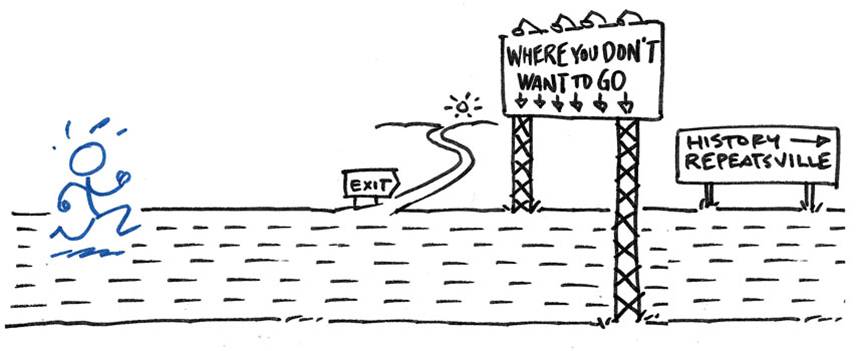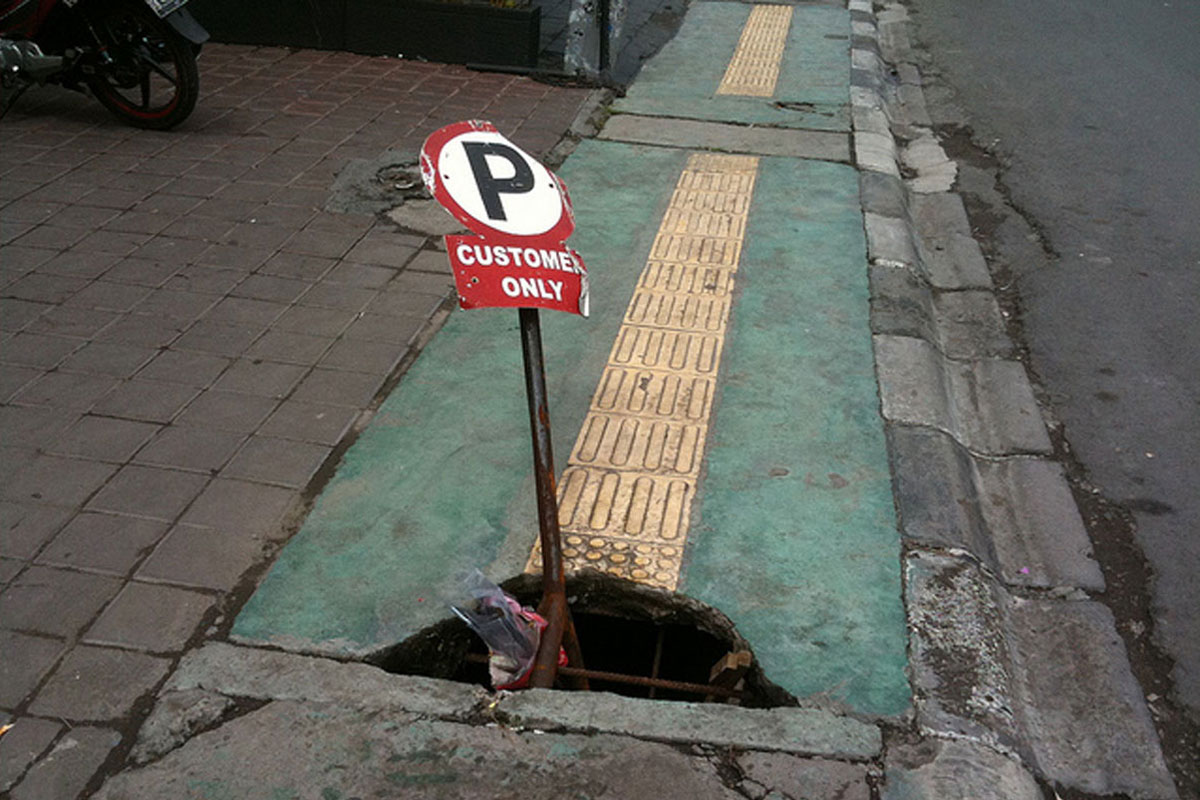The Wise Business Owner’s Guide to Pothole Repair
It works. No matter what business you are in. Really. The math is the same.
There is a funny but ironic story (by Portia Nelson the link takes you to the complete version) that perfectly illustrates the dilemma that plagues business owners pushing the gas on growth. This shorter version goes like this:
- You are walking to your destination. Suddenly you fall into a huge pothole. Shocked and shaken, you pull yourself out.
- The next day, you walk to your destination and notice the pothole just as you fall in. Frustrated and frayed, knowing it’s just your habit, you pull yourself out.
- The day after, you walk to your destination, notice the pothole, walk around it and trip on the edge. Daunted yet determined, you step out.
- The next day, you walk past the street with the pothole and take a new route.

Unfortunately, or fortunately, this is the way we learn. It’s the hard way, through experience. Our pothole experiences make us great observers and pattern recognizers.  If we take the time to process what happened and think about what we want to do instead, a silver lining is the reward for all the pain and drama.
However, life is so busy, we often don’t take the time to think, question, mull and connect the dots on our life experiences or what the day to day activity in our business means about how likely we are to hit growth goals.
This habit pattern becomes our comfort zone.
It’s our thinking habits that get in the way of breaking through growth barriers to find the smooth road ahead. We’d rather rush to the next item on the to do list, than review what worked, what didn’t and how our own thinking led us to the problem we now face.
Here are three ways to re-think your habitual actions on 3 classic growth potholes we see in many kinds of businesses:
1. Profits or Revenue? Which says more about your ability to grow your business?

When framed this way, you know the answer is profits. But your brain drips dopamine in anticipation of higher revenues. Dopamine is the great feeling you get when anticipating something really good. It’s rather addictive.
How come you pump your fist when revenues grow and trumpet what it means about your business but don’t do the same about profits? There might be several reasons, but here’s the most likely.
Revenue growth proves your business is wanted by customers. This is a very powerful feeling. Feeling wanted is tribal, visceral, vital to your emotional sense of well being. It means you’re part of, you’re moving forward, you have momentum. What you’ve created is valued by others. That validation is precious to our self-esteem. And proof to others that you are successful. It’s also very reassuring. So you may have developed a habit of not digging around for anything that is not reassuring. Anything that will blow that high.
Pothole Repair – Revenue vs Profits
Yet it’s profits (Net Margin, the money left before paying taxes) that puts money in your pocket, funds the resources for your next stage of growth and really proves your business is a money maker.
Think of profits this way: for every $1 of revenue your company receives, how much do you want to take home and make available for more growth? Grocery stores on average, are lucky to have 2-3 cents left. Retail 4 cents. Contractors 7 cents. Professional services 7 cents. Restaurants 9 cents. Software 19 cents.

Yes, celebrate your revenue wins. But track your profit margin. Graph it each month. Know what individual locations, products, services or packages drive your net margin growth. Then calculate the change between last month and this month as a percentage of revenue. [{This month’s net margin – last month’s net margin}/last month’s net margin]
Graph that change. Then ask yourself and your team why this product does better than that one. Listen to the answers. Test your theories.
Don’t assume you know the answers. Your best mindset through this exploration is to say “I don’t know” until the evidence provides you with answers so that you do you know. Assuming you know, that you’re right, before you really are, or are not, will keep you and your team small. Assumptions and proving each other right or wrong is the fast road to conflict and team dysfunction.
Do not model the habit of proving you are right. It’s why most average net margins are smaller than they need to be.
Your industry has a net margin average. You should know it. Then make a plan to beat it. Which brings us to the next growth pothole.
2. What Drives Your Growth? – Goals or Measures?
Well everyone knows the answer to this. You set goals right. Then get everyone aligned and boom, growth appears. Or it doesn’t.

Here are the top three contributors to not reaching goals:
- You didn’t measure which parts of your business are the most profitable and which drive revenue (see #1 above). So you don’t know which lever to push to activate a goal.
- The strategic goal isn’t broken down into interdependent activities that each department knows is their contribution to that goal.
- Some goals are at cross-purposes with other goals or with performance incentives which leads to competition between departments.
Pothole Repairs – Goals or Measures
Frame the goal Some goals aren’t achievable in the way they are stated. Sure you want to grow revenue, but is that the best way to express it. Why do you want to grow revenue? That’s a better question.
If you sell services, do you want more billable hours or more billable hours for specific types of projects?
If you sell contracting, do you want to win more of any kind of construction projects, or only those with a higher probability of winning at a likely profit margin with partners you work well with?
If you sell products, do you want to sell more of all products, or the higher margin product that your target market is not price sensitive about?
If you sell through distributors, do you want to stand back and demand they bring you more revenue, or work alongside of them on finding opportunities for those products that have the best gross margin?
Map Out All Necessary Actions Say your goal is to sell more high margin products. You also decide to put your prices up on those products.
So you reset your price list and call the project done. Sorry. This is only the start of this project.
How do you want your team to communicate these price changes so that relationships are preserved, the focus isn’t on price and your team feel comfortable being drilled by the 2-3 loyalists with good memories that grouse about your price increase? Role play. Practice how you want your front line staff to deliver and respond.
How will you determine how well the price increase is performing for your bottom line so you know if it was enough or not? Graph the change in unit sales and net margin.
Goals at Cross Purposes Say you want to increase billable hours but your best people are already at capacity. Do you instantly go hire more?
Well you know that it takes someone time to become able to deliver value at full utilization. So you can’t put your foot to the gas quite yet.
But you can prepare marketing, sales, HR and your onboarding team so that you start finding the opportunities you do want, at the same time you are finding the star performers that can deliver the value and preparing them so they do it your way.
Another goal that gets companies in trouble is relying too much on just a few customers to get more of their business instead of searching for new business. Never have more than 60% of your revenue coming from less than 3 customers.
3. Who Should Be Accountable for Goals? Department Heads or Teams?
Tough question. There is a right answer. But it may mean you have to change who has power and authority in your company. I bet you want your department heads to have ultimate authority.
But when and why? The right answer is: the team responsible for delivering the project that satisfies the goal. (See #1 and #2).
I know, its far easier to give one person all the authority all the time. Then you know who to blame right? Effectiveness is the enemy of the comfort zone.

What are the signs you have this problem in your company?
- Many complaints. They have become personal.
- Goals not met.
- Deadlines missed.
- People can’t find files, paperwork, notes.
- The workplace atmosphere is tight, anxious, quiet.
- No one speaks up at meetings.
- Emails describing why things didn’t happen and who is responsible are cc’d to the boss.
Pothole Repairs for Accountability for Goals
If you want your business to grow, to achieve these goals, turn down the drama/politics/blaming and increase profitability so that you take home more of that dollar, then you need to organize your company around workflow.
Each person is responsible, accountable and has authority for their part of the workflow.
Yes, there should be someone ultimately responsible, accountable and have authority for the entire project. But without the team each having clear authority for their part, work does not flow.
There are two new ways of working you have to adopt if this problem is plaguing your work environment:
-  1. RACI – Responsibility, Accountability, Consult, Inform system of deciding who needs to be part of what.
- Â 2. Swimlane diagrams to map the workflow from person to person so you know who has responsibility and accountability for all actions, deadlines and paperwork at each step of the process.
It is important to note that if you have long standing conflicts between people then it may be very hard to get people to talk about how to re-design the workflow when they are barely speaking to each other. You will need two additional ingredients to resolve this problem.
- 1. A complaint collection process so that everyone can say what their struggles, concerns and observations are without naming names. This has to be a blame free process or you’ll never hear what’s really going on. When it becomes personal, no one can hear what the workflow problems are. It’s just a sea of painful confusion.
- 2. competent facilitator who can lead you through the complaint collection process, then take the complaints and turn them into solutions working with the team who has the complaints. Then you’re ready to design a new workflow, with that team and at least two company leaders who will be held accountable for goals.
In Closing…
You may wonder why I don’t use real life stories to explain these three game changers. We have many. We also happily sign NDAs.
And the blog post would be too long and you might not read it.
Suffice to say that any one of these mindset changes have proved profitable for our clients. Contractors. Restauranteurs. Real estate developers. Manufacturers. Distributors. Software makers. Predictive Analytics. Big data service solutions.

Here’s takeaways…
- Growth is a team sport.
- What gets measured gets managed.
- Everyone has a role to play.
- Give authority, unless you want to do everything yourself.
- The way to get buy-in is to include everyone in the change process, rather than dictating the change, post planning.
- When hearing complaints and conflict, face it, listen in. It’s a sign that ineffective workflow is impeding your growth.
- There is gold in following this plan. It goes in your pocket and funds your future.





